For faster or lazier work, a very wide selection of rotary tool bits are available from very small dental or engraver types to large saw blades and grinders. Materials range from cloth, paper and animal bristles through rubber, copper, steel, carbide, sand, silicates to diamond. All types of shapes are available. Each has its own specialized design purpose, but use can be extended to the extent of the imagination. Shape names are inconsistent among manufactures and users.
Presenting a problem, shank diameters vary and may not fit collets supplied with tool. Common are 1/8" (Dremel) and 3/16" (Fordom). Imported may 2 mm, 2.4 mm (3/16") or 3 mm. To avoid the problem, eliminate collet change and handle various drill bit shanks , an adjustable chuck is recommended.
 CAUTION:
CAUTION:
- Eye protection must be worn. Small chips and abrasives are thrown
out at high speeds and may become embedded in eye tissue.
- High RPM should not be used with wire brushes, since weakened wires may
become projectiles, which can penetrate skin. Stone grinders may fly apart.
above some critical RPM.
- A firm grip must be maintained at all times. A bit can dig into softer
material and grab; twisting tool with considerable torque.
- Do not work bits to edges in the direction of pull. Bit
can roll over and down the adjacent side uncontrollably , causing damage and
injury.
- Use a holder for smaller parts to avoid cutting supporting hand.
Metal cutters are generally used for faster removal of softer materials. They cut similar to chisels or files and are commonly called rotary files or burs. The smallest are dental engraver's or jeweler's types. Frequently they have only end teeth, similar to some end mill bits and are used in much the same way; but mostly freehand. With fewer flutes, router bits can work wood and plastics.
For faster removal bits may range up to about 1/2". Attention must be paid to the fact that surface cutting speed, at a fixed RPM, increases proportional to the diameter. Over heating bit can easily destroy cutting ability. If bouncing is noted, bits are out of round and do not run true. Most bits are high speed (HS) steel, but some are offered in carbide

Note: Adjust brightness and contrast for optimum viewing.
METAL CUTTERS
Small cylinder.
Sharp engraving.
Small cone.
Large oval.
Large cylinder.
Router
Router bits can be very useful around the layout to make things fit or even on some larger model projects. Caution: high RPM can burn and ruin bits.

Note: Adjust brightness and contrast for optimum viewing.
ROUTER BITS
Saw or slitting cutters are similar, but have teeth only around the circumference. Thicknesses start at about .010" and diameters vary greatly up to about 3". Care must be exercised to maintain cutting angle or kerf will widen and blade may jam. Larger sizes are more critical and very dangerous. While Dremel mounts blades permanently on shaft, due to a law suite, most require a mandrel. Thicker versions are commonly used to cut notches and slots and are sometimes called keyway cutters.
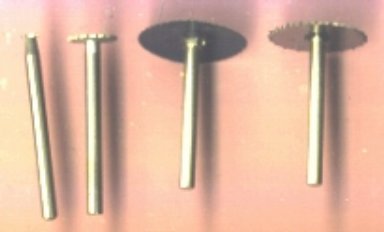
Note: Adjust brightness and contrast for optimum viewing.
SAW BITS
Small keyway.
Larger keyway.
Thin saw.
Thicker saw.
 Very dangerous saw blades up to
about 2" diameter are available. These should only be chucked in bench
tools like the Unimat,drill presses or milling machines. Precautions must
be exercised or a finger may be lost.
Very dangerous saw blades up to
about 2" diameter are available. These should only be chucked in bench
tools like the Unimat,drill presses or milling machines. Precautions must
be exercised or a finger may be lost.

Note: Adjust brightness and contrast for optimum viewing.
2" SAW ON MANDREL.
Abrasive stones are made from various fine crushed oxides fused together to shape. Colors usually indicate the abrasive used and the cutting ability. Some are graded to cut glass and ceramics. Grits may vary from fine polishing to coarse fast cutting. They have a tendency to load up with softer materials.

Note: Adjust brightness and contrast for optimum viewing.
STONE ABRASIVE.
Fine flat end.
Glass cone.
Cylinder.
Bullet
Round end cylinder.
Wheel.
Note shiny spot on wheel, from loading with soft metal. The opposite side has a similar spot, proving that some Dremel bits do not run true. Foredom's are superior and cost less.
Foredom and Cratex offer unmounted, abrasive filled rubber bits in various shapes and sizes. Since the rubber has more give than stone or metal cutters a smoother finish can be attained. Fine grits can produce an excellent polished surface.
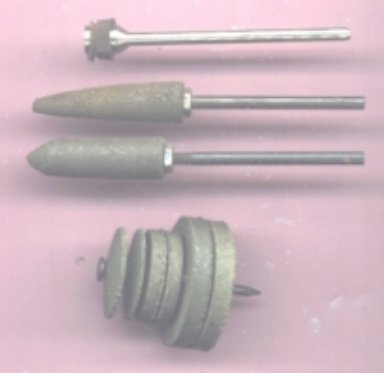
Note: Adjust brightness and contrast for optimum viewing.
ABRASIVE FILLED RUBBER
More recently reduced to hobby affordable prices, Diamond bits are now available in a large variety of shapes and sizes. Fine grits are bonded to metal forms providing a sturdy backup. These can cut almost any material and speeds are not critical to the bits. Since most of these are imported, shafts may not be standard.
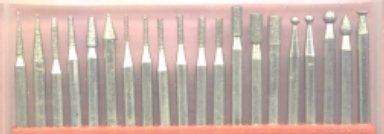

Note: Adjust brightness and contrast for optimum viewing.
DIAMOND BITS
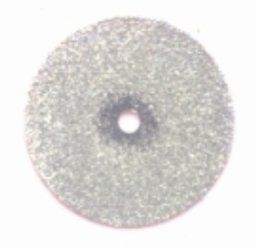
Note: Adjust brightness and contrast for optimum viewing.
DIAMOND SAW BIT
Requires special sized mandrel.
Face can be used as sander.
A few years ago Robart introduced a bur with radiating spikes of tungsten carbide in 3 degrees of coarseness and various shapes for very fast removal of material. Too large for delicate modelling, they later produced smaller sizes. Dremel and others followed suit. Unfortunately high pressure can strip points and softer materials tend to clog them, More recently Foredom has released the Typhoon line, with superior quality; but more expensive..

Note: Adjust brightness and contrast for optimum viewing.
TUNGSTEN CARBIDE SPIKED BITS
Finer ball.
Round edge wheel.
Cylinder with evidence of loading.
Typhoon ball end cylinder.
Possibly the most useful bit on metal is the cutoff wheel, which can be used to remove flash, shape, trim to length and almost anything where it will fit. Sold in packs of 36 in a plastic tube with a cap, at a very reasonable price, the Dremel 409 disk was great. The only drawback was that side pressure broke it very easily. After about 4 or 5 packs, I never succeeded in wearing one out, before it broke. In despair 2 were placed together with a drastic reduction in breakage. Finally Robart offered a large disk with reinforcement mesh embedded in it. A little later they added smaller sizes comparable to the 409. This probably inspired Dremel to introduce a thicker. more robust 420 with 20 pieces per pack. There are now several choices to suit taste.

Note: Adjust brightness and contrast for optimum viewing.
CUTOFF BITS
Dremel thin 409.
Dreme thicker 420.
Reinforced.
Lower.
Small reinforced
Larger reinforced.
Sanding bits are available in disk, drum and flapper in various grits. Lower priced are often paper backed, but cloth and mylar (Flexi-grit) are also used. With disks the mandrel screw head presents a hazard and prevents flat sanding. Some use pressure sensitive disks on a backing. Drums are usually sleeves mounted on a rubber cylinder which expands to hold sleeve when mandrel screw is tightened.

Note: Adjust brightness and contrast for optimum viewing.
SANDING BITS
Disk. Requires mandrel.
Drum.
Flapper (Gyros)
Wire brushes usually come in wheels, cups and straight. Bristles may be animal, nylon, brass or steel dependent on the material worked. Caution must be exercised since excessive speed can soften or melt plastic, permitting bristles to gouge. These are excellent for removing rust and other oxides. Paint and lettering are more difficult..
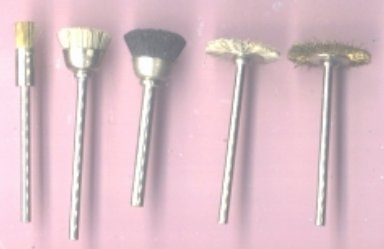
Note: Adjust brightness and contrast for optimum viewing.
WIRE BRUSHES
Steel straight.
Soft cup
Nylon cup
Brass wheel.
Steel wheel.
The most common material for buffer bits is felt formed into cylinders, bullets or some times tapered wheels. The first two are usually mounted on a wood screw type mandrel along with thicker wheels, Thinner ones often use a large shouldered mandrel with a large headed screw or a washer under the head. These are usually used with abrasive pastes such as jeweler's 's rouge, or even tooth paste or scouring powder to obtain a polished surface.

Note: Adjust brightness and contrast for optimum viewing.
BUFFER BITS
Bullet.
Tapered edge.
Thick wheel.
Thin wheel.
Pressure sensitive back.
Some bits require special mandrels for different size holes, mount type or support . Many are included with bit. If the wrong one is used, the bit could easily be off center.

Note: Adjust brightness and contrast for optimum viewing.
MANDRELS
Small for diamond saws
Standard
Standard
Standard
Large shoulder and screw head
Rubber drum for sanding sleeves.
BACK TO HOLDING
BACK TO ROTARY HANDTOOLS
BACK TO TOOLS INDEX
